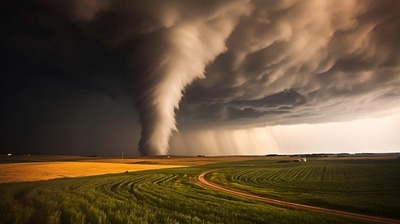Tornado Safety - Severe Weather Awareness Week 2025
Thursday, April 10th, 2025 -- 1:00 PM

(Part 4 of a 5 part series)
We all remember when we were students in school during the 2nd week of April, our principals or administrator would announce over the pa system to go to the hallway and sit crouched next to the wall with our hands shielding our heads for the annual tornado drill.
We all thought our schools were a safe place to be in a storm. On Labor Day 2002, an F2 tornado hit Gilman High School. Thankfully it was a holiday and classes were not is session but the high school football team was practicing outside but they moved inside the building due to the storms that were moving into the area.
The tornado initially touched down about a mile northwest of Gilman, WI at approximately 5:10 pm and then moved through Gilman where it blew the roof off of the high school at 5:12 pm and damaged trees, homes, and power lines.
Strong winds blew through the school's hallways, like a wind tunnel, blowing out doors and ripping the ceiling tiles out. The tornado damage in Gilman was ranked as a strong F1.
The Gilman football team only had less than 2 minutes of warning to take shelter because the weather radio was locked in the school office. This same tornado then continued intermittently on the ground east southeast from Gilman through the Chequamegon National Forest.
Prior to dissipating, the tornado damaged a house and trees about 7 miles west of Medford between 5:45 pm and 6 pm. It was here that the tornado produced the F2 damage.
At 1:45 pm and 6:45 pm today, area communities may sound their storm sirens. You will hear a steady 3 minute blast. Remember the oudoor sirens are just that, to warn you when you are outdoors.
It is a good practice to have a weather radio in your home and at your place of employment to notify you when your indoors. Take a moment today during these drill times and ask yourself, if I had to take shelter now, where would I go?
Tornado Safety Begins Before the Storm
- Being ready for severe weather starts before there are even storms in the forecast. Make sure you are taking several precautions at home, work, and school to ensure everyone remains safe when severe weather threatens.
- Develop a plan for you and your family for home, work, school and outdoors.
- Know the safest shelter areas in multiple locations and regularly practice your plan. Shelters can include a basement, a ground-floor interior room with shared walls with the outside, or a safe room built to withstand strong winds and falling debris.
- Keep a disaster supply kit in your home which should include water, food that won’t spoil and does not need to be heated to serve, a first-aid kit, a NOAA Weather Radio, a flashlight and some special items for children, pets and elderly family members.
- Make sure you have multiple ways to receive weather information. A NOAA Weather Radio, local TV and radio stations, and smart phone apps can keep you informed when severe weather threatens.
- If you have a smart phone, make sure your device is enabled to receive Wireless Emergency Alerts (WEA). These life-saving messages can provide critical early warnings about approaching dangerous weather conditions.
Tornado Safety During the Storm
- Whether at home, work, or school, it’s important to have a plan in place for what to do when severe weather is approaching.
- In a home or building, move to a pre-designated shelter, such as a basement, and get under a sturdy table or the stairs. A specially constructed “safe room” within a building offers the best protection.
- If a basement is not available, move to a small interior room on the lowest floor and cover yourself with anything close at hand: towels, blankets, pillows. If possible, get under a sturdy table, desk, or counter. Put as many walls as possible between you and the storm. Stay away from windows.
- If caught outdoors, seek shelter in a sturdy building. If you cannot quickly walk to shelter, get into a vehicle, buckle your seatbelt and drive to the closest sturdy shelter. If flying debris occurs while you are driving, pull over and park. Now you have two options as a last resort:
- Stay in the vehicle with the seatbelt on and place your head below the windows.
- If you can safely get noticeably lower than the roadway, exit the vehicle and lie in that area, covering your head with your hands. Do not seek shelter under an overpass.
- Mobile homes, even if tied down, offer little protection from tornadoes. You should leave a mobile home and go to the designated storm shelter or the lowest floor of a sturdy nearby building.
There were 45 confirmed tornados that occured in Wisconsin in 2024, which makes the year the 3rd highest ever recorded. In fact, one third of those tornados happened near communities right here in central Wisconsin.
In the past 15 years, annual totals have ranged from as few as 4 to as many as 62 per year. The peak months for tornados are April through August. In Wisconsin, history states that a tornado can happen in any month of the year.
In 2024, Wisconsin recorded its first ever February tornado. Tornadoes can happen at all times of the day but most frequently occur between 3 and 9 pm. 80% of Wisconsin tornados are relatively weak with winds that are under 110 mph.
Only 1% of Wisconsin's ever recorded tornadoes were of the violent nature with winds above 165 mph. Tornadoes are surviveable if you take the proper precautions and plan appropriately.
For more information on Severe Weather Awareness Week, you can go to any of our local national weather service office websites or to the Wisconsin Emergency Management's website at wem.wi.gov.
Feel free to contact us with questions and/or comments.




